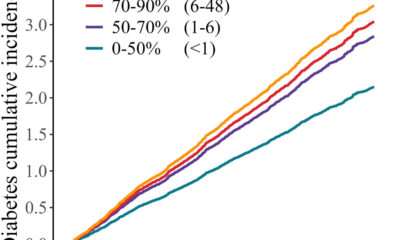Food
Bird flu remains widespread but still poses a low risk to humans

Widespread H5 bird flu remains a low health risk to humans, according to the federal Centers for Disease Control and Prevention in Atlanta. The assessment comes after a third human case since 2022 was recently reported in the United States, and the second involving exposure to dairy cows this year.
Although the current public health risk is low, the CDC is monitoring and working with states to monitor people to whom animals are exposed. The agency uses its flu surveillance systems to monitor for H5N1 activity in people. The CDC flu surveillance systems show no indicators of unusual flu activity in humans, including avian flu A(H5N1).
CDC and state and local health departments monitor people exposed to infected birds, poultry or other animals for 10 days after exposure. At least 9,300 people have been monitored for exposure to infected poultry between February 2022 and now, and a further 300 people have been exposed to livestock for ten days since March. These include:
- At least 325 people were tested for novel influenza A after exposure to poultry.
- At least 37 people tested for new influenza A after exposure to livestock.
The only cases of human bird flu are two cases of exposure to dairy cows in Texas in April and the recent event in Michigan. In 2022, a poultry worker in Colorado became infected. All three recovered. However, public health officials continue to remind people not to consume raw, unpasteurized milk.
Since early 2022, bird flu has spread globally, including 48 states, and has affected 90.8 million U.S. commercial poultry flocks and 52 dairy farms. The fatalities in the US included 9,352 wild birds. Bird flu has also sporadically killed hundreds of mammals, including opossums, skunks, red foxes, bobcats, minks and many others.
CDC is the lead agency for human health. The current H5N1 avian flu situation in wild birds and poultry, dairy cows, and sporadic infections in other mammals is the responsibility of USDA’s Animal and Plant Health Inspection Service (APHIS). The U.S. Department of the Interior and USDA are the lead federal departments for investigating and controlling outbreaks in wild birds and agriculture.
The CDC’s response to this outbreak of influenza A(H5N1) virus in dairy cattle and other animals largely recently includes:
- Continue to support states that monitor people exposed to cows, birds, or other domestic or wild animals infected or potentially infected with avian influenza virus A(H5N1). State or local officials test symptomatic people with exposure, and the CDC conducts confirmatory testing when necessary.
- Ongoing discussions with multiple states about state-led field studies to investigate important scientific and public health questions related to the ongoing outbreak. CDC coordinates research protocols so that data collection can be standardized across states and results can be pooled. CDC’s multilingual and multidisciplinary epidemiology field teams are standing by, ready to deploy to support on-site investigations if requested.
- Work to make personal protective equipment (PPE) available to affected farmworkers by requesting that jurisdictions use their existing supplies for workers on dairy farms, poultry farms and slaughterhouses, prioritizing the distribution of PPE to affected farms. HHS/ASPR has indicated that it can supply PPE from the strategic national stockpile if necessary.
- Continue work to better characterize the virus based on the human case in Texas
- Continue to work with commercial diagnostic test manufacturers and clinical partners to make progress toward the goal of an A(H5N1) test that is widely available when needed.
- The process will continue so that all states can perform A(H5) testing on eye specimens using the CDC’s H5 test.
- Continue to engage One Health partner organizations in public health, agriculture, wildlife, milk regulatory officials and others to share information and ensure preparedness to prevent and respond to this emerging threat of infectious diseases and potential human infections comment.
- Continue to monitor influenza surveillance data, especially in areas where A(H5N1) viruses have been detected in dairy cattle or other animals, for any unusual trends in influenza-like illness, influenza, or conjunctivitis.
(To sign up for a free subscription to Food Safety News, click here.)













